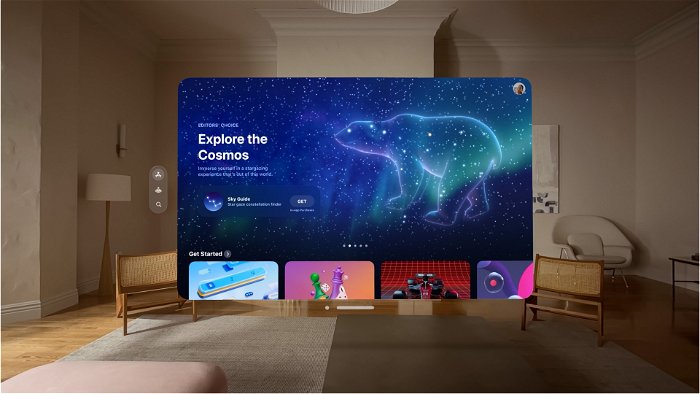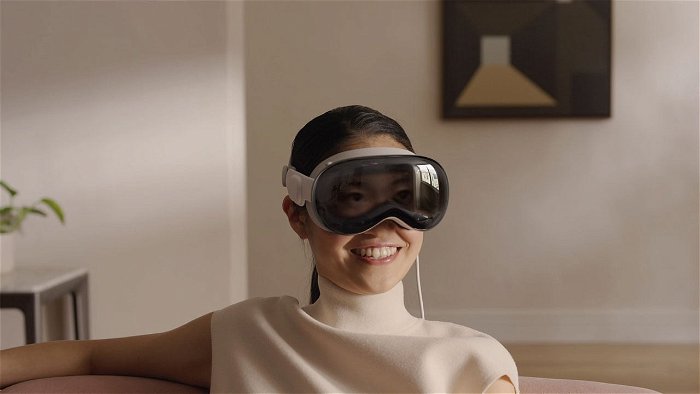Hailed as their first “spatial computer,” Apple debuted the Vision Pro at WWDC 23 today—their new AR/VR headset which will arrive next year.
Apple’s Tim Cook once again had “one more thing” to relay at the end of the company’s Worldwide Developers Conference presentation today: the long-rumoured augmented reality headset, the Vision Pro.

Dubbing it their first “spatial computer,” the Vision Pro “seamlessly blends digital content with the physical world”—extending digital workspaces and entertainment like a VR headset, yet not cutting users off from the world around them. The headset’s unique operating system, visionOS, will create “an infinite canvas” across a fully three-dimensional interface controlled by the user’s eyes, hands, and voice.
The Vision Pro is powered by Apple silicon in a unique dual-chip design—an M2 chip like those found currently in devices like the iPad Pro and the new 15″ MacBook, and a brand-new R1 chip that processes input from 12 cameras, five sensors, and six microphones to ensure that content feels like it is appearing right in front of the user’s eyes, in real-time. This new chip streams images to the displays in less than the blink of an eye (within 12 milliseconds, to be precise).
Still, images don’t quite do justice to the concept; check out the big reveal of the Apple Vision Pro below:
“Creating our first spatial computer required invention across nearly every facet of the system,” said Mike Rockwell, Apple’s vice president of the Technology Development Group, who added that the company filed over 5000 patents during development. “Through a tight integration of hardware and software, we designed a standalone spatial computer in a compact wearable form factor that is the most advanced personal electronics device ever.”
The device’s goal is to bring “a new dimension” to personal and workplace computing, changing how we interact with apps and media and how we communicate through apps like FaceTime. Its three-dimensional interface unshackles apps from monitors, allowing them to appear side-by-side at any scale across its “infinite screen real estate.”
Putting the “space” in “spatial computer,” the Apple Vision Pro aims for unparalleled immersion. FaceTime participants will appear in life-size tiles, feeling like they’re in the physical space around the user, while participants who are also using their own headsets will be reflected by digitally-recreated Personas built on scans of their faces.
Spatial Audio will similarly redefine the experience of watching shows and movies. Even panoramic photos taken on other devices can be expanded across the display to recreate the feeling of being in that spot. Videos recorded with the device are captured in 3D, allowing users to “relive” their memories digitally.

Though it may resemble other VR headsets like Sony’s PlayStation VR2, the Apple Vision Pro will utilize the new EyeSight technology to allow others to see the user’s eyes. EyeSight allows the user’s eyes to be seen when someone else approaches and also allows them to see the other person, in theory preventing the sort of isolation traditional VR causes. The digital crown dial on the side will allow users to customize how much of the outside world they can see while in use.
The screen itself is a “singular piece of three-dimensionally formed and laminated glass,” “polished to create an optical surface that acts as a lens for the wide array of cameras and sensors needed to blend the physical world with digital content.” It’s housed in an aluminum alloy frame which curves around the user’s face and is held with a single-piece, knitted headband.
The Apple Vision Pro’s micro-OLED display provides full 4K video with wide colour and high dynamic range, utilizing custom catadioptric lenses. However, if you wear glasses normally, you’ll need special ZEISS Optical Inserts (sold seperately) to maintain visual fidelity.

Other features of the Apple Vision Pro include:
- All-day use when plugged in, or up to two hours of use with its external battery
- Support for Magic Keyboard and Magic Trackpad
- Transport a Macbook’s display into the immersive display just by looking at it through the lenses
- Individually amplified drivers on each side of the device deliver Personalized Spatial Audio based on the user’s own head and ear geometry
- An eye tracking system uses high-speed cameras and a ring of LEDs, projecting invisible light patterns onto the user’s eyes for responsive, intuitive input
- visionOS responds dynamically to natural light and shadows to make digital content look and feel present in a user’s physical world
- Gestures from the user’s eyes, hands, and voice will enable navigation and engagement with spatial content—for example, by tapping their fingers to select, flicking their wrist to scroll, using voice to dictate, or simply looking at them
- Over 100 Apple Arcade games will support the Vision Pro, enabling play on screens as large as users wish, alongside immersive audio, and users can even connect select game controllers (like the PS5’s DualSense) via Bluetooth
- A seperate App Store will offer apps supported by the headset, including both brand-new apps built for it as well as compatible iPhone or iPad apps
- Optic ID is the next evolution of Face ID, analyzing the user’s iris with invisible LED light exposures that can even differentiate between identical twins
- Eye-tracking and iris scan data is protected by the Secure Enclave, like Face ID, to keep sensitive information private—not accessible by apps, and stored on the device only, not on Apple servers

“Today marks the beginning of a new era for computing,” said Tim Cook, Apple’s CEO. “Just as the Mac introduced us to personal computing, and iPhone introduced us to mobile computing, Apple Vision Pro introduces us to spatial computing. Built upon decades of Apple innovation, Vision Pro is years ahead and unlike anything created before — with a revolutionary new input system and thousands of groundbreaking innovations. It unlocks incredible experiences for our users and exciting new opportunities for our developers.”
The Apple Vision Pro certainly sounds revolutionary on paper, if not ripped from science fiction works like Ready Player One. However, we’ll have to wait until next year to see how it works in practice. Rollout will begin in the US alone sometime next year, with the headset starting at $3499 USD (approx. $4700 CAD).





